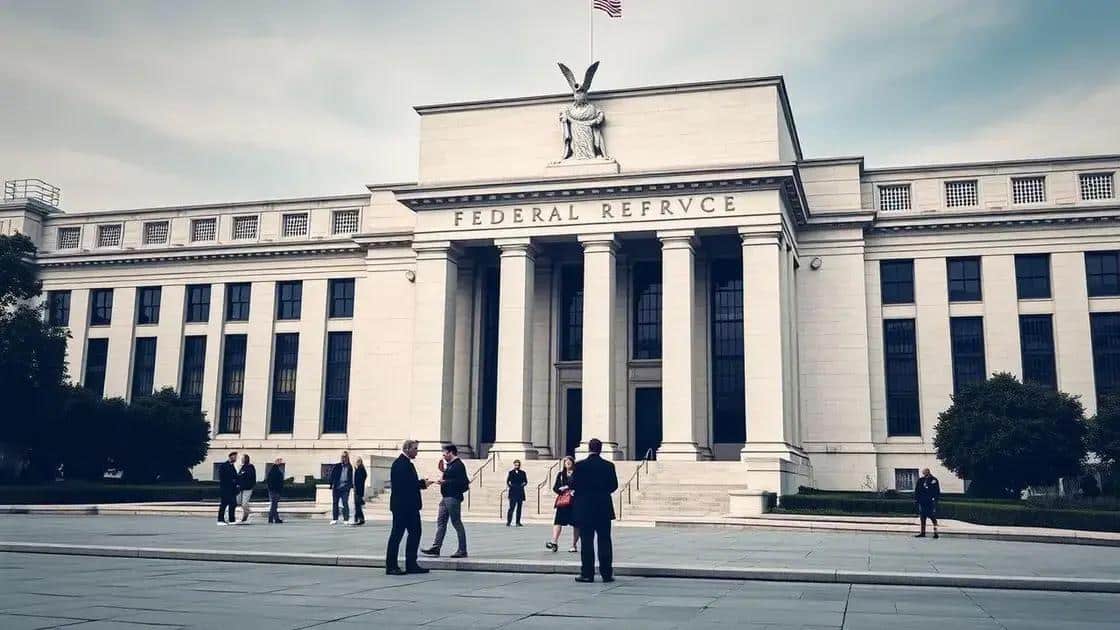Federal Reserve speeches and market response: what you should know

Federal Reserve speeches and market response significantly influence investor strategies, as changes in interest rates and monetary policy signals affect stock prices, bond yields, and overall market volatility.
Federal Reserve speeches and market response are crucial in shaping our financial landscape. Have you ever wondered how these speeches influence investor sentiment and trading strategies? Let’s explore this intriguing connection.
Understanding the Federal Reserve’s role
The Federal Reserve plays a vital role in the U.S. economy, serving as the nation’s central bank. Its decisions can significantly impact financial markets, inflation, and employment rates. Understanding how the Fed operates is crucial for anyone looking to navigate the complexities of the economic landscape.
The Functions of the Federal Reserve
The Federal Reserve performs several key functions. Firstly, it manages the country’s monetary policy, steering the economy by controlling interest rates. Secondly, it supervises and regulates banks to ensure safety and soundness in the financial system. Lastly, it provides financial services to the government and financial institutions.
- Monetary Policy: Adjusting interest rates to influence economic activity.
- Bank Supervision: Ensuring that banks operate safely and comply with laws.
- Financial Services: Acting as a bank for the U.S. government.
Each of these functions carries weight in economic discussions. For instance, when the Fed raises interest rates, it can cool down an overheating economy. On the other hand, lowering rates can stimulate spending and investment. Traders and investors closely monitor these changes, making the Fed’s announcements all the more impactful.
Decision-Making Process
The decision-making process within the Federal Reserve involves the Federal Open Market Committee (FOMC). This group meets regularly to evaluate economic conditions and determine the appropriate monetary policy. Their discussions take into account various factors, including inflation trends and employment rates.
After each meeting, the Fed releases a statement outlining its decisions. These communications are essential as they provide insights into the Fed’s outlook on the economy. Investors adjust their strategies based on the information communicated, demonstrating the interconnectedness of Federal Reserve policies and market responses.
Key speeches and their historical impacts

Key speeches by the Federal Reserve have historically influenced the market and shaped economic policies. These speeches offer insights into the Fed’s perspective on the economy and future plans. Most notably, speeches from the Fed Chair are closely watched by traders and investors alike.
The Importance of the Fed Chair’s Speeches
The Chairperson of the Federal Reserve, often seen as the face of monetary policy, delivers speeches that can sway market sentiment. For example, when the Chair hints at potential interest rate hikes, it can lead to a rise in bond yields and a dip in stock prices. The language used in these speeches is scrutinized for clues on the Fed’s stance concerning inflation and employment.
- Impact on Interest Rates: Signals changes that affect borrowing costs.
- Market Reactions: Can lead to volatility as traders react quickly.
- Guiding Economic Expectations: Helps shape forecasts among economists.
Another significant event is the annual Jackson Hole Economic Symposium, where various Fed officials discuss their views on economic prospects. These discussions can provide strategic insights into the Fed’s policy direction. In past years, crucial shifts in economic policy have emerged from these meetings, showcasing their importance.
Notable Historical Speeches
Throughout history, specific speeches have had lasting effects. Ben Bernanke’s speech during the financial crisis in 2008 reassured markets with promises of liquidity and support for financial institutions. In contrast, Janet Yellen’s remarks about the labor market recovery in 2015 emphasized the Fed’s cautious approach to raising rates. Each of these instances illustrates how a single speech can change market dynamics significantly.
Additionally, the introduction of forward guidance marked a pivotal shift in Federal Reserve communication. This strategy involves giving explicit signals about future monetary policy to influence economic activity. By shaping expectations, the Fed can mitigate adverse effects during economic fluctuations.
Market reactions to recent Fed announcements
Market reactions to recent Federal Reserve announcements are crucial in understanding how monetary policy impacts the economy. Each time the Fed releases a statement, investors watch closely to gauge the potential effects on the markets.
Immediate Market Response
When the Fed announces changes in interest rates or future guidance, the stock and bond markets typically react swiftly. For instance, a rate hike can lead to a drop in stock prices as borrowing costs rise. Conversely, a rate cut usually lifts market sentiment, often resulting in a stock market rally.
- Stock Prices: Tend to fall with increased interest rates.
- Bond Yields: Often rise when the Fed signals tighter policy.
- Currency Strength: The U.S. dollar may strengthen with higher rates.
Understanding these immediate responses helps investors navigate the volatility that can ensue after any Fed meeting. Traders often use these opportunities to adjust their portfolios based on perceived future economic conditions.
Long-Term Market Effects
In addition to immediate reactions, the long-term effects of Fed announcements can shape market trends over time. For example, when the Fed indicates a consistent policy direction, it can influence investor confidence and economic forecasts. A clear commitment to controlling inflation may bolster confidence, supporting market stability.
Moreover, the Fed’s communication style is essential. If the statements are vague or ambiguous, markets may react negatively, leading to volatility until clearer guidance emerges. This uncertainty often affects consumer confidence and spending, which are critical for economic growth.
Furthermore, during times of economic uncertainty, the Fed’s announcements can serve as a guide for investors. By signaling their priorities, such as employment or inflation control, the Fed can help set a direction for market participants.
Strategies for investors based on Fed communications

Strategies for investors based on Federal Reserve communications are essential for navigating the complexities of the financial markets. When the Fed speaks, it can create opportunities for investors to adapt their strategies effectively. By understanding the implications of Fed announcements, traders can position themselves ahead of market movements.
Interpreting Fed Messages
To develop effective strategies, investors need to carefully interpret the messages conveyed in Fed communications. This involves monitoring both the language used in statements and the context surrounding them. Subtle changes in wording can signal shifts in monetary policy, which can have significant implications for various asset classes.
- Watch for key phrases: Look for terms like “accommodative” or “restrictive.” These words can indicate future actions.
- Consider economic indicators: Pay attention to how the Fed views unemployment, inflation, and growth.
- Market expectations: Assess how traders are reacting to the Fed’s statements in real-time.
Understanding the nuances of Fed communications allows investors to anticipate how markets may react and adjust their positions accordingly.
Long-Term vs. Short-Term Strategies
Investors often employ different strategies based on their investment horizons. For short-term traders, reacting quickly to Fed news is crucial. This might mean adjusting positions right after a press conference or statement to capitalize on immediate market changes. On the other hand, long-term investors can use Fed communications to inform more strategic decisions. For instance, if the Fed signals prolonged low interest rates, it might be an opportunity to invest in sectors that benefit from cheap borrowing costs.
Additionally, diversifying portfolios in response to Fed signals is a common strategy. By including a mix of assets, investors can protect themselves against volatility caused by unexpected Fed announcements. Staying informed about Fed discussions and broader economic trends helps in making wise investment choices.
Ultimately, the ability to read and react to the Federal Reserve’s communications plays a critical role in an investor’s success. By understanding the signals the Fed sends, investors can navigate risks and seize opportunities effectively.
FAQ – Frequently Asked Questions about Federal Reserve Communications and Investment Strategies
How do Federal Reserve announcements affect the stock market?
Federal Reserve announcements can lead to significant changes in the stock market, as traders adjust their investments based on the Fed’s signals regarding interest rates and economic outlook.
What should investors watch for in Fed speeches?
Investors should pay attention to key phrases and language used in Fed speeches, as subtle changes can indicate shifts in monetary policy or economic strategy.
How can I develop an investment strategy based on Fed communications?
By carefully interpreting the Fed’s messages, focusing on interest rate signals, and adjusting your portfolio in response to their announcements, investors can create effective strategies to capitalize on market opportunities.
What role does inflation play in Fed decisions?
Inflation is a critical factor for the Federal Reserve; their decisions on interest rates are often influenced by current inflation rates and their goals for price stability.





